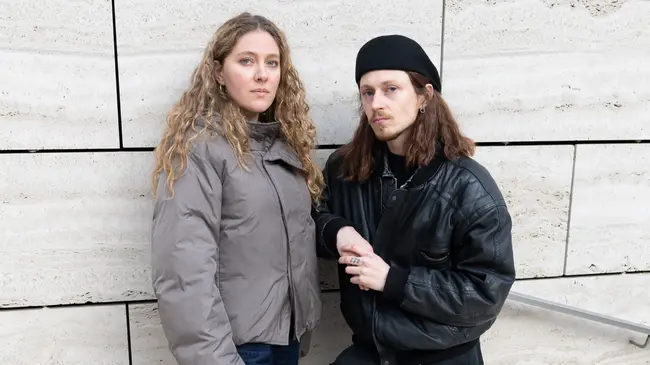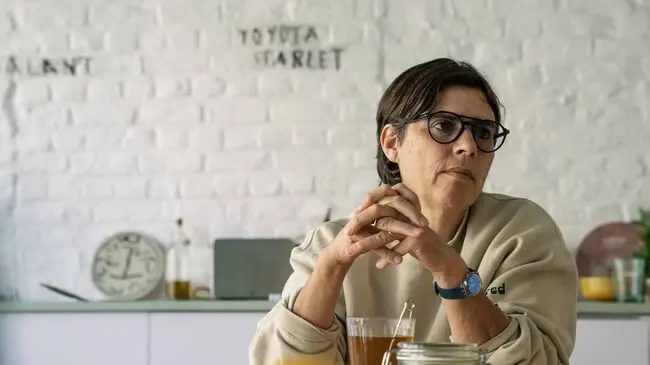The (g)host as an invisible present form

Every year M HKA will invite one artist to become their Superhost. For their first edition, they began a ‘relationship’ with Berlin-based artist Hanne Lippard. In her three-part programme Contact Mood Share, which represents imagined seasons, she’s focussing on language and especially the vocabulary and semiology that comes with social changes and developments. From one screen to another we’re talking about the act of listening, sound sculptures and (g)hosting.
You became M HKA's first Superhost, what does this entail?
The Superhost project has the idea of doing something, seeing what it is, learning from it and then doing it again but differently. Rather than working, working, working up until the opening of the exhibition and then cutting, the project works more in cycles. When I started there was actually no clear indication of what the role of the ‘host’ would be. The exhibition wasn't the intended form, this idea came up later. We wanted to show existing work of mine in a more retrospective way although the intention of the exhibition is to grow and start inviting people, to let it open to others' involvement, to release me a bit and to create a dialogue.
M HKA is expressing a desire for more institutional transformation, permeability and exchange. How do you see your role in this as a host?
It’s challenging right now because there are fewer artistic encounters due to the pandemic and the restrictions on social life. It’s very strange because that’s how artists have been working for decades: as part of a scene, exchanging ideas since the beginning of the 20th century. This whole idea of meeting in communal spaces is quite important for artistic practice and is absent right now. So we’ll have to find other ways, which will also be a part of the topic of the show.
Your programme Contact Mood Share represents imagined seasons. What do these seasons look like?
There was the idea of committing to host a program for a whole year but then again it’s only nine months, which means three seasons. The idea of seasons came from the absence of actual seasons It's like there’s a little bit of spring, then it’s super hot, then it’s winter and next week it’s spring. Everything is shuffled in time. The focus of the exhibition is on words and the multiple meanings they can contain. The first season is named Contact which was an important word the last year as physical contact is seen as a dangerous act. I don’t know how we will relate to contact once things turn to - I don’t wanna say normal - but perhaps less pandemic.
The focus of the exhibition is on words and the multiple meanings they can contain.
Which artists will you collaborate with?
The first person I will collaborate with is the musician Laurel Halo. I already worked with her last year, and now we’ll do a performance together. On the 12th of June, we’ll invite Ania Nowak, she’s a performance artist. Both artists are Berlin-based. Through the project, I hope to get more involved in what’s happening in Belgium so I can invite more local people. Actually, I wanted to invite more people but it feels very strange to find them through Google Search - I want to meet people myself. Luckily I have a gallerist who’s living in Brussels, and I’ve already been exhibiting and working in Belgium, so I’m not completely disconnected. I don’t really know the scene yet but that's one of my aims.
How did you bring your voice into the spaces of M HKA?
There are three sound installations which came out of the notion that programming live moments would be more difficult than usual. There is one six-channel sound installation which is a voice piece accompanied by an older work. They are like sound sculptures. One of them is a recording of my voice imitating a phone in silent mode, attached to a glass plate. When you place it on a surface it reverberates on the material. It’s an imitation of a machine using the human voice. You can’t tell that the sound is coming from the body unless you listen carefully. When you remove the body from the voice, you’re dealing with a ghost. Which is for me connected to the role of the host. The (g)host as an invisible present form.
How do you imagine the spectator moving through your work?
One has to think about catching the audience's attention. Most of the time works that include sound, also videoworks, get easily passed by. Sound in particular is very fragile so that's why it’s all about composition and accomodation. You have to practice a dynamic between all the pieces. For example the six-channel sound sculpture is a vocal piece that would be difficult to place in relation to other audible works. When I place two voice installations in one space it becomes too much for the brain. Eyes can take in multiple things at once but you can not do this with your ears. In other works I have created specific installations where you can enter and listen to a piece in its whole. When it’s done and you leave, it’s the closest I can get to imitate the experience of a performance in a permanent state.
Sound in particular is very fragile so that's why it’s all about composition and accommodation. You have to practice a dynamic between all the pieces.
How important is it for you to create a space where listening together feels comfortable?
Sound has the capability of being very comfortable and uncomfortable in a split second. For example, when watching a horror movie, it's the sound that really affects you, more so than the visuals. I think it’s never my intention to make something purely comfortable. Being at the intersection of these two opposites is what makes the work interesting.
Listening to spoken text is something fleeting: one moment it’s there in space and then immediately it disappears again. How important is this elusive aspect to you?
I’m trying to control this as much as possible. For instance, I’m very often asked if there could be something printed next to my installations. As it’s language, people still interpret it as information. I’m trying to avoid the idea that you can always contain it. My work can still be logical and comprehensible, it’s not like a complete stream of consciousness. We are nowadays very used to being able to always go back, scrolling on a timeline. I want to avoid the idea of jumping back and relocating the logic. Thousands of years ago stories and narratives were handed over through memory but were not used to this way of containing information anymore since we started printing and containing information visually. With the sound installations, you can always stay there and listen to them over again, however. The fluidity is part of it.
As it’s language, people still interpret it as information. I’m trying to avoid the idea that you can always contain it.
How differently do we listen to recordings compared to a live voice?
We often associate a sound installation as cold, versatile and clinical, or even sci-fi. When it’s a performance we're in a dialogue with a body, even though we’re not really in a dialogue. I see the live readings as books, my voice as a binder for multiple texts, while in my installations I usually focus on one text and try to create a spatial experience with that text. When I perform a reading where there are multiple texts within a certain topic or a mood, there is a beginning and an ending which makes a clear difference. Art spaces often work with looping, where you have to loop everything because there is always a new audience. I don’t think I would ever perform in a loop; I think it’s very exhausting.
The act of listening is increasingly fading from our daily lives. Are you trying to maintain this experience with your work?
Yes, but without being too nostalgic about it. The world is aimed towards literacy, so we can never return to this state of only perceiving language as the audio. On the other hand, I notice that the way we write has become much more vocal. For example, texting or vocal messages are nowadays more about using your voice when previously the text in books or newspapers was written and then printed and nobody couldn’t say anything about it apart from writing a letter to the editor. Now the conversation is everywhere and manifold. Which is very intense, if you think about how we are talking to multiple - and many - people a day.
Which word or sentence would you like to hold very carefully in a box?
My sentence would be a translation of a Norwegian saying: ‘Having one bird in the hand is better than having ten on your roof.’
Different Class works with the interest of their community at heart.
Our work’s purpose is to foster a solid network for independent artists, those who love them, and those who want to support them. Become a member to contribute to the local Belgian art scene.





